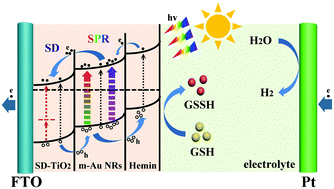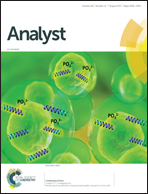Hemin/Au nanorods/self-doped TiO2 nanowires as a novel photoelectrochemical bioanalysis platform†
Abstract
As a recently developed detection technique, photoelectrochemical (PEC) measurement has received extensive attention. However, owing to the lack of a comprehensive approach to engineer the photo-generated carriers, the performance is still limited. As an example, a significant use of PEC measurement might be in understanding the roles of glutathione in physiological and pathological processes. Here, we developed a new approach for engineering the photo-generated carriers with the aid of the synergic effect of self-doping, surface plasmon resonance, electrical field amplification effect, etc. Thus, a highly sensitive multicomponent PEC platform has been developed, in which Au nanorods are decorated on the surface of self-doped TiO2 nanowires, followed by surface receptor functionalization with hemin for capturing glutathione. The synergic effect effectively increases generation, separation and transfer kinetics of the photo-generated carriers, which can be further increased by using a mixture of Au nanorods with different aspect ratios to tune the absorption wavelength to the entire UV-visible region. As a result, this system exhibits a broad linear range from 10 nM to 17.5 μM and low detection limit down to 8.6 nM for detecting glutathione, about 1–2 orders of magnitude lower than most existing PEC sensors.



 Please wait while we load your content...
Please wait while we load your content...